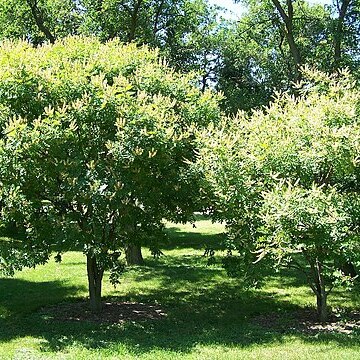Trees deciduous, to 15 m tall, to 60 cm d.b.h.; bark green-brown, scaly; branches purple-brown, lenticellate, hairy when young, then glabrous; buds glabrous. Leaves 15-23 cm; leaflets 7-9(-11); petiolule 3-6 mm; blades ovate to obovate-elliptic, 3.5-6.8(-9.7) × (1-)2-3.5(-5) cm, papery, densely hairy when young, becoming glabrate, rarely sparsely villous near main vein abaxially, base broadly cuneate or cuneate, apex acute to acuminate. Racemes 5-9 cm; rachis densely brown hairy. Flowers 0.8-1.2 cm; pedicel (3.2-)4-6(-10) mm. Calyx campanulate, 2.1-4 mm; teeth short, densely yellow-brown appressed pubescent. Corolla white, 7-11 mm; standard obovate, apex emarginate, narrowing to claw at base; wings oblong, 2-auriculate at base. Ovary linear, densely yellow-brown hairy. Legumes dark brown, linear, 3-7 × 1-1.2 cm, pubescent or subglabrous, wing 0.4-1.2 mm; stalk 5-10 mm. Seeds 1-4, yellow to yellow-brown, long elliptic, 6-8 mm. Fl. Jun-Jul, fr. Sep-Oct.
More
A shrub or tree. It grows 18 m high. The bark is coppery brown and peels off. The leaves are 20 cm long and are divided into leaflets along the stalk. There are 7 to 13 leaflets. The flowers are on erect crowded stalks. They are white with a pale blue tint. The pods are dark brown and 3-7 cm long by 1 cm wide. There are 1-4 seeds.
Forests on hill slopes; at elevations frpm 300-900 metres in Hebei, Heilongjiang, Jilin, Liaoning, Nei Mogol and Shandong Provinces, China.
More
It is a temperate plant. it grows on hill slopes in north China between 300-900 m above sea level. It suits hardiness zones 5-7.


